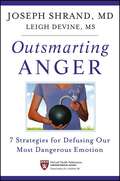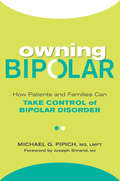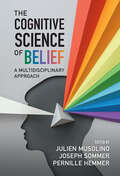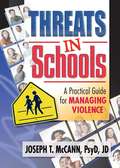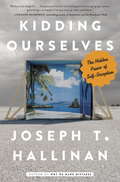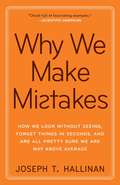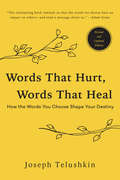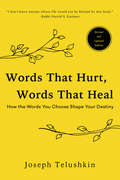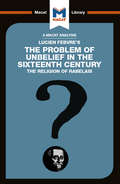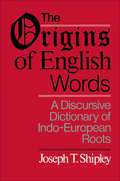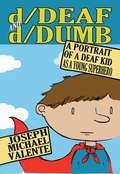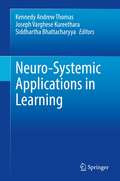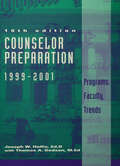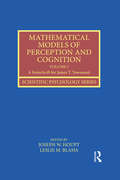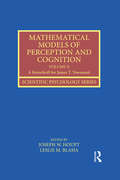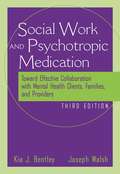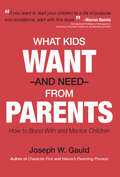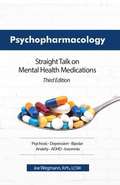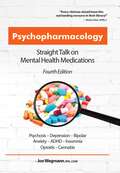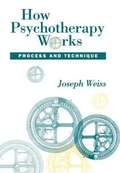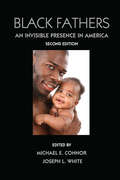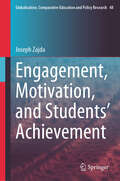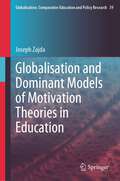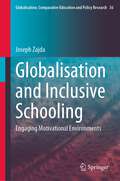- Table View
- List View
Outsmarting Anger: 7 Strategies for Defusing Our Most Dangerous Emotion
by Joseph Shrand Leigh DevineSurefire strategies for transforming anger in yourself and others In this must-have resource, Dr. Joseph Shrand offers seven innovative yet remarkably uncomplicated strategies to help turn powerful anger impulses into positive, success-oriented actions. <P><P>These brain-based techniques teach you how to recognize the many forms of anger we all experience, and how to tap into your brain's very own anger absorption zone the prefrontal cortex. Dr. Shrand also explores the ways these techniques can be used to harness the anger of others. When we learn to recognize and defuse the anger response of any individual, we improve our chances for success in every aspect of life.Explains how the power of anger can be turned into much more productive behaviorsOutlines 7 simple strategies for outsmarting the lizard brain and the primitive limbic systemPublished in partnership with Harvard Health publications, a division of Harvard Medical SchoolOutsmarting Anger helps you manage and decrease not only your own anger, but the anger of people around you so everyone can be more successful.
Owning Bipolar: How Patients and Families Can Take Control of Bipolar Disorder
by Joseph Shrand Michael G. Pipich“Essential reading, not only for the person learning to own their bipolar, but for the support system members and treatment providers walking alongside them in their journey to hope and healing.” —Sally Spencer-Thomas, PsyD, president United Suicide Survivor’s International Knowledge is power, and grasping the basics of bipolar disorder can give you the power you need to detect it, accept it, and own the responsibility for treatment and lifelong disease management. With its three-phase approach, Owning Bipolar can help you and your loved ones become experts at an illness that has called the shots in your life for too long. Now it’s time for you to take control. · The Pre-stabilization phase and recognition: confronting the causes of bipolar and the effects, including depression, anxiety, loss of energy, avoidance of responsibilities, and suicidal thoughts · The Stabilization phase and acting on it: starting effective medication, accepting the disease, and treating different types of bipolar · The Post-stabilization phase and living with it: undertaking long-term maintenance, accepting your new identity, and coming to terms with your responsibilities, and the responsibilities of your caregivers Accessible and encouraging, and accented with empathetic first-hand stories from people who share the disorder, this book is a vital companion for readers to help them understand, treat, and live successfully with bipolar. “Will provide clarity and understanding to a seemingly complex and confusing psychiatric condition.” —David B. Weiss, MD, FAPA
The Cognitive Science of Belief: A Multidisciplinary Approach
by Julien Musolino Joseph Sommer Pernille HemmerBeliefs play a central role in our lives. They lie at the heart of what makes us human, they shape the organization and functioning of our minds, they define the boundaries of our culture, and they guide our motivation and behavior. Given their central importance, researchers across a number of disciplines have studied beliefs, leading to results and literatures that do not always interact. The Cognitive Science of Belief aims to integrate these disconnected lines of research to start a broader dialogue on the nature, role, and consequences of beliefs. It tackles timeless questions, as well as applications of beliefs that speak to current social issues. This multidisciplinary approach to beliefs will benefit graduate students and researchers in cognitive science, psychology, philosophy, political science, economics, and religious studies.
Threats in Schools: A Practical Guide for Managing Violence
by Joseph T MccannManage potentially violent situations in your school with these expert techniques!In the wake of several highly publicized school shootings, the problem of school violence has increasingly become a focus of concern for the general public as well as teachers, school officials, and students. Drawing on case studies from publicized violent incidents as well as from Dr. McCann's private practice, Threats in Schools: A Practical Guide for Managing Violence provides techniques for identifying, conceptualizing, assessing, and managing threatening behavior by students in school settings. Offering specific case management strategies for a variety of situations, this indispensable volume provides guidance on formulating questions to ask and suggestions for developing strategies for managing potentially violent situations.Integrating threat assessment and risk management models, this approach will help you target potential threats to property, other students, teachers, and school staff. The interdisciplinary approach recognizes that violent behavior is dependent on the characteristics of the perpetrator, victim, and setting, and that the relationship between threats and violence is not always clear. Threats in Schools offers well-grounded research, detailed case studies, and theoretical approaches to help you deal with the tough issues, including: zero-tolerance policies and their more effective alternatives why profiling techniques to identify violence-prone students are of limited use interventions to defuse potentially violent situations critical incident stress managementFive appendixes offer forms and checklists to help you plan and evaluate, including: threat assessment and management planning checklist of characteristics of perpetrators of school violence questions for evaluating general risk of violence fire-setting and bombing risk assessment sex offense risk assessmentLucidly written and illustrated with helpful tables and figures, Threats in Schools offers school officials, mental health professionals, community leaders, and the media the information they need to understand what sparks school violence and which approaches reduce the risk of it.
Kidding Ourselves
by Joseph T. HallinanFrom the Pulitzer Prize-winning journalist and author of Why We Make Mistakes, an illuminating exploration of human beings' astonishing ability to deceive themselves. To one degree or another, we all misjudge reality. Our perception--of ourselves and the world around us--is much more malleable than we realize. This self-deception influences every major aspect of our personal and social life, including relationships, sex, politics, careers, and health. In Kidding Ourselves, Joseph Hallinan offers a nuts-and-bolts look at how this penchant shapes our everyday lives, from the medicines we take to the decisions we make. It shows, for instance, just how much the power of many modern medicines, particularly anti-depressants and painkillers, is largely in our heads. Placebos in modern-day life extend beyond hospitals, to fake thermostats and "elevator close" buttons that don't really work...but give the perception that they do. Kidding Ourselves brings together a variety of subjects, linking seemingly unrelated ideas in fascinating and unexpected ways. And ultimately, it shows that deceiving ourselves is not always negative or foolish. As increasing numbers of researchers are discovering, it can be incredibly useful, providing us with the resilience we need to persevere, in the boardroom, bedroom, and beyond. Provocative, accessible, and easily applicable to multiple facets of everyday life, Kidding Ourselves is an extraordinary new exploration of our mind's flexibility.
Why We Make Mistakes: How We Look Without Seeing, Forget Things in Seconds, and Are All Pretty Sure We Are Way Above Average
by Joseph T. HallinanWe forget our passwords. We pay too much to go to the gym. We think we'd be happier if we lived in California (we wouldn't), and we think we should stick with our first answer on tests (we shouldn't). Why do we make mistakes? And could we do a little better?We human beings have design flaws. Our eyes play tricks on us, our stories change in the retelling, and most of us are fairly sure we're way above average. In Why We Make Mistakes, journalist Joseph T. Hallinan sets out to explore the captivating science of human error--how we think, see, remember, and forget, and how this sets us up for wholly irresistible mistakes.In his quest to understand our imperfections, Hallinan delves into psychology, neuroscience, and economics, with forays into aviation, consumer behavior, geography, football, stock picking, and more. He discovers that some of the same qualities that make us efficient also make us error prone. We learn to move rapidly through the world, quickly recognizing patterns--but overlooking details. Which is why thirteen-year-old boys discover errors that NASA scientists miss--and why you can't find the beer in your refrigerator. Why We Make Mistakes is enlivened by real-life stories--of weathermen whose predictions are uncannily accurate and a witness who sent an innocent man to jail--and offers valuable advice, such as how to remember where you've hidden something important. You'll learn why multitasking is a bad idea, why men make errors women don't, and why most people think San Diego is west of Reno (it's not).Why We Make Mistakes will open your eyes to the reasons behind your mistakes--and have you vowing to do better the next time.
Words That Hurt, Words That Heal, Revised Edition: How the Words You Choose Shape Your Destiny
by Joseph TelushkinFrom the New York Times bestselling author of Rebbe comes this newly revised edition of Words That Hurt, Words That Heal—an invaluable guide in how choosing the right words can enrich our relationships and give us insight to improve every facet of our lives.“I don’t know anyone whose life would not be blessed by this book.”—Rabbi Harold S. Kushner, author of When Bad Things Happen to Good People and Nine Essential Things I’ve Learned About Life Joseph Telushkin is renowned for his warmth, his erudition, and his richly anecdotal insights, and in Words That Hurt, Words That Heal he focuses these gifts on the words we use in public and in private, revealing their tremendous power to shape relationships. With wit and wide-ranging intelligence, Rabbi Telushkin explains the harm in spreading gossip, rumors, or others’ secrets, and how unfair anger, excessive criticism, or lying undermines true communication. By sensitizing us to subtleties of speech we may never have considered before, he shows us how to turn every exchange into an opportunity.In this fully revised edition, Joseph Telushkin brings this classic into the modern age. Remarkable for its clarity and practicality, Words That Hurt, Words That Heal illuminates the powerful effects we create by what we say and how we say it.
Words That Hurt, Words That Heal: How To Choose Words Wisely And Well
by Joseph TelushkinJoseph Telushkin is renowned for his warmth, his erudition, and his richly anecdotal insights, and in Words That Hurt, Words That Heal he focuses these gifts on the words we use in public and in private, revealing their tremendous power to shape relationships. With wit and wide-ranging intelligence, Rabbi Telushkin explains the harm in spreading gossip, rumors, or others' secrets, and how unfair anger, excessive criticism, or lying undermines true communication. By sensitizing us to subtleties of speech we may never have considered before, he shows us how to turn every exchange into an opportunity. Remarkable for its clarity and practicality, Words That Hurt, Words That Heal illuminates the powerful effects we create by what we say and how we say it.
The Problem of Unbelief in the 16th Century (The Macat Library)
by Joseph TendlerFebvre asked this core question in The Problem of Unbelief: “Could sixteenth-century people hold religious views that were not those of official, Church-sanctioned Christianity, or could they simply not believe at all?” The answer informed a wider debate on modern history, particularly modern French history. Did the religious attitudes of the Enlightenment and the twentieth century—notably secularism and atheism—first take root in the sixteenth century? Could the spirit of scientific and rational inquiry of the twentieth century have begun with the rejection of God and Christianity by men such as Rabelais, writing in his allegorical novel Gargantua and Pantagruel – the work most often cited as a proto-"atheist" text prior to Febvre's study? The debate hinged on some key differences of interpretation. Was Rabelais mocking the structures of the Christian Church (in which case he might be anticlerical)? Was he mocking the Bible scriptures or Church doctrines (in which case he might be anti-Christian)? Or was he mocking the very idea of God’s existence (in which case he might be an atheist)? <P><P>The other great contribution that Febvre made to the study of history can be found not so much in the fine detail of this work as in the additions that he made to the historian's toolkit. In this sense, Febvre was highly creative; indeed it can be argued that he ranks among the most creative of all historians. He sought to move the study of history itself beyond its traditional focus on documentary records, arguing instead that close analysis of language could open up a gateway into the ways in which people actually thought, and to their subconscious minds. This concept, the focus on "mentalities," is core to the hugely influential approach of the Annales group of historians, and it enabled a switch in the focus of much historical inquiry, away from the study of elites and their deeds and towards new forms of broader social history. Febvre also used techniques and models drawn from anthropology and sociology to create new ways of framing and answering questions, further extending the range of problems that could be addressed by historians. Working together with colleagues such as Marc Bloch, his understanding of what constituted evidence and of the meanings that could be attributed to it, radically redefined what history is – and what it should aspire to be.
The Origins of English Words: A Discursive Dictionary of Indo-European Roots
by Joseph Twadell ShipleyThere are no direct records of the original Indo-European speech. By comparing the vocabularies of its various descendants, however, it is possible to reconstruct the basic Indo-European roots with considerable confidence. In The Origins of English Words, Shipley catalogues these proposed roots and follows the often devious, always fascinating, process by which some of their offshoots have grown.Anecdotal, eclectic, and always enthusiastic, The Origins of English Words is a diverting expedition beyond linguistics into literature, history, folklore, anthropology, philosophy, and science.
D/deaf And D/dumb: A Portrait Of A Deaf Kid As A Young Superhero (Disability Studies In Education Ser. #10)
by Joseph Valented/Deaf and d/Dumb chronicles the author's dumb, 'deaf kid' origins in Bayport, New York to his current life as a «young superhero» writer. Portraying the conflicting cultural worlds of hearing and Deaf, it describes his life in an in-between underworld and his identity as it alternates between being oppressed and empowered. These feelings are inescapably and forever the reality of those who live on the margins of our larger society.
Neuro-Systemic Applications in Learning
by Siddhartha Bhattacharyya Joseph Varghese Kureethara Kennedy Andrew ThomasNeuroscience research deals with the physiology, biochemistry, anatomy and molecular biology of neurons and neural circuits and especially their association with behavior and learning. Of late, neuroscience research is playing a pivotal role in industry, science writing, government program management, science advocacy, and education. In the process of learning as experiencing knowledge, the human brain plays a vital role as the central governing system to map the images of learning in the human brain which may be called educational neuroscience. It provides means to develop a common language and bridge the gulf between educators, psychologists and neuroscientists. The emerging field of educational neuroscience presents opportunities as well as challenges for education, especially when it comes to assess the learning disorders and learning intentions of the students. The most effective learning involves recruiting multiple regions of the brain for the learning task. These regions are associated with such functions as memory, the various senses, volitional control, and higher levels of cognitive functioning. By considering biological factors, research has advanced the understanding of specific learning difficulties, such as dyslexia and dyscalculia. Likewise, neuroscience is uncovering why certain types of learning are more rewarding than others. Of late, a lot of research has gone in the field of neural networks and deep learning. It is worthwhile to consider these research areas in investigating the interplay between the human brain and human formal/natural learning. This book is intended to bring together the recent advances in neuroscience research and their influence on the evolving learning systems with special emphasis on the evolution of a learner-centric framework in outcome based education by taking into cognizance the learning abilities and intentions of the learners.
Counselor Preparation 1999-2001: Programs, Faculty, Trends
by Joseph W. HollisNow in its tenth edition, this classic reference contains vital information in three major areas: Detailed information on each of more than 500 graduate level departments with more than 1000 counselor preparation programs; Statistical treatment with interpretations of composite national research on the six largest types of entry level (master's and sixth year) and four doctoral level counseling programs; trends based on comparison of 1999 data with longitudinal data collected periodically since 1970. New in this tenth edition is a chapter on 'The Road to Professionalism which emphasizes the individual's need to gain strong backgrounds for certification and other programs. As in previous editions, all master's and doctoral level counselor and/or therapist preparation programs in the U.S. are listed, including community, marriage/family, mental health, pastoral, gerontological, rehabilitation, school, career, and student affairs counseling. Also noted are programs accredited by the American Association for Marriage and Family Therapy, American Association of Pastoral Counselors, Council for Accreditation of Counseling and Related Educational Programs, and Council on Rehabilitation Education - plus it identifies the location of Chi Sigma Iota (Counseling Society International) chapters.In addition to listing faculty by name, degree, title, and time devoted to each program, the text gives detailed information for each separate program: degree offered; accreditation held (if any); departmental addresses and telephone numbers; admission and graduation requirements; number of students admitted and graduating yearly; experiential clock hours; placement of graduates; and the uniqueness within the program. Courses to be added or dropped by counseling departments are listed, as are other anticipated changes within departments. Using a statistical treatment of the aforementioned data, the book also interprets the status and probable trends of preparation programs within each counseling specialty. Also considered are current emphases in the counseling field, and in what ways these are being reflected within counselor education settings.
Mathematical Models of Perception and Cognition Volume I: A Festschrift for James T. Townsend (Scientific Psychology Series)
by Joseph W. Houpt Leslie M. BlahaIn this two volume festschrift, contributors explore the theoretical developments (Volume I) and applications (Volume II) in traditional cognitive psychology domains, and model other areas of human performance that benefit from rigorous mathematical approaches. It brings together former classmates, students and colleagues of Dr. James T. Townsend, a pioneering researcher in the field since the early 1960s, to provide a current overview of mathematical modeling in psychology. Townsend’s research critically emphasized a need for rigor in the practice of cognitive modeling, and for providing mathematical definition and structure to ill-defined psychological topics. The research captured demonstrates how the interplay of theory and application, bridged by rigorous mathematics, can move cognitive modeling forward.
Mathematical Models of Perception and Cognition Volume II: A Festschrift for James T. Townsend (Scientific Psychology Series #2)
by Joseph W. Houpt Leslie M. BlahaIn this two volume festschrift, contributors explore the theoretical developments (Volume I) and applications (Volume II) in traditional cognitive psychology domains, and model other areas of human performance that benefit from rigorous mathematical approaches. It brings together former classmates, students and colleagues of Dr. James T. Townsend, a pioneering researcher in the field since the early 1960s, to provide a current overview of mathematical modeling in psychology. Townsend’s research critically emphasized a need for rigor in the practice of cognitive modeling, and for providing mathematical definition and structure to ill-defined psychological topics. The research captured demonstrates how the interplay of theory and application, bridged by rigorous mathematics, can move cognitive modeling forward.
The Schema in Clinical Psychoanalysis
by Joseph W. Slap Laura Slap-SheltonSlap and Slap-Shelton proffer the schema as the basis of an internally consistent and clinically relevant model of the mind. Wedded to the dynamic and genetic points of view, the schema model accommodates the clinical realities of trauma, repetition, and sublimation while dispensing entirely with the abstract concepts of traditional metapsychology.
The Social Worker and Psychotropic Medication: Toward Effective Collaboration with Mental Health Clients, Families, and Providers (3rd edition)
by Joseph Walsh Kia J. BentleyIntended for social workers who want to understand the drugs prescribed to their clients, this text describes the central nervous system, the basic principles of pharmacology, and the specific disorders treated by antipsychotics, antidepressants, mood stabilizers, anti-anxiety drugs, and psychostimulants. The third edition reflects new medications and new uses of medications across diagnostic categories.
What Kids Want and Need From Parents
by Joseph Warren GauldWhat Kids Want-And Need-From Parents is truly a seminal book in parenting.It begins with one man's 50-year journey to discover a better way to prepare American kids for life and culminates with the amazing discovery: the biggest factor in children's success in life turns out to be dependent on how their parents deal with their own childhood!Teacher Joe Gauld sets out to change American education in the 60s, founding the Hyde School in Bath, Maine, committed to the idea every student is gifted with a unique potential. But by tracking Hyde graduates in life, he finds parenting a much larger influence on their later lives than schooling. So in 1974, he begins a program to regularly address parental growth and family issues.Hyde's extraordinary ability to bond family and school receives national media attention, and Hyde grows into a network of seven private and public schools, plus a national Hyde Biggest Job® parent program.Joe increasingly centers his work on families, finding parenting heavily influenced by how parents were raised. So parents' learning how to effectively deal with both the negative as well as the positive aspects of their upbringing becomes critical to effective parenting. Joe carefully leads the reader through this dynamic and ground-breaking parenting process.
Psychopharmacology: Straight Talk on Mental Health Medications
by Joseph Wegmann<p>Congratulations to Joe Wegmann, and his book, Psychopharmacology, 3rd Edition, for winning a silver medal at the 2016 IBPA Benjamin Franklin Awards for editorial and design excellence in the Professional & Technical category. <p>This is the definitive guide and desk reference for healthcare professionals and patients to expand their knowledge in the pharmacological and behavioral treatment of psychosis, anxiety, depression, bipolar, insomnia and ADHD.</p>
Psychopharmacology: Straight Talk on Mental Health Medications
by Joseph WegmannA comprehensive professional resource for mental health treatment – now in it’s fourth edition! Since 2009, Psychopharmacology: Straight Talk on Mental Health Medications has been the go-to desk reference for professionals who want to expand their knowledge of pharmacological treatment on mental health issues. Author Joe Wegmann draws on over three decades of clinical experience in psychopharmacology and psychotherapy, to provide his unique perspective on psychotropic medication management. He is nationally known for the practical, relevant, and insightful psychopharmacology information he presents in his books, columns, articles, blogs, and workshops – and this edition is no exception. Packed with detailed discussions of clinical diagnoses, as well as the effectiveness of current treatments, including complementary and alternative medicine, this fourth edition provides the reader a useable blend of the science and art associated with contemporary best practices.
How Psychotherapy Works: Process and Technique
by Joseph Weiss<P>In the landmark volume, THE PSYCHOANALYTIC PROCESS, Joseph Weiss presented a bold, original theory of the therapeutic process. Now, in HOW PSYCHOTHERAPY WORKS, Weiss extends his powerful theory and focuses on its clinical applications, often challenging many familiar ideas about the psychotherapeutic process. <P>Weiss' theory, which is supported by formal, empirical research, assumes that psychopathology stems from unconscious, pathogenic beliefs that the patient acquires by inference from early traumatic experiences. He suffers unconsciously from these beliefs and the feelings of guilt, shame, and remorse that they engender, and he is powerfully motivated unconsciously to change them. According to Weiss's theory, the patient exerts considerable control over unconscious mental life, and he makes and carries out plans for working with the therapist to change his pathogenic beliefs. He works to disprove these beliefs by testing them with the therapist. The theory derives its clinical power not only from its empirical origin and closeness to observation, and also from Weiss's cogent exposition of how to infer, from the patient's history and behavior in treatment, what the patient is trying to accomplish and how the therapist may help. By focusing on fundamental processes, Weiss's observations challenge several current therapeutic dichotomies--"supportive versus uncovering," "interactive versus interpretive," and "relational versus analytic." <P>Written in simple, direct language, Weiss demonstrates how to uncover the patient's unconscious plan and how the therapist can help the patient to carry out his plans by passing the patient's tests. He includes many examples of actual treatment sessions, which serve to make his theory clear and usable. The chapters include highly original views about the patient's motivations, the role of affect in the patient's mental life, and the therapist's basic task. The book also contains chapters on how to pass the patient's tests, and how to use interpretation with the patient. Dr. Weiss also provides a powerful theory of dreams and demonstrates how dreams can be utilized in clinical practice. <P>This distinguished volume is a major contribution that will profoundly affect the way one conceptualizes and practices therapy. Theoreticians, investigators, and clinicians alike will find it enlightening reading.
Black Fathers: An Invisible Presence in America, Second Edition
by Joseph White Michael E. ConnorThis book offers a broader, more positive picture of African American fathers. Featuring case studies of African-descended fathers, this edited volume brings to life the achievements and challenges of being a black father in America. Leading scholars and practitioners provide unique insight into this understudied population. Short-sighted social policies which do not encourage father involvement are critically examined and the value of father engagement is promoted. The problems associated with the absence of a father are also explored. The second edition features an increased emphasis on: the historical issues confronting African descended fathers the impact of health issues on Black fathers and their children the need for therapeutic interventions to aid in the healing of fathers and their children the impact of an Afrikan-centered fathering approach and the need for research which considers systemic problems confronting African American fathers community focused models that provide new ideas for (re)connecting absent fathers learning tools including reflective questions and a conclusion in each chapter and more theory and research throughout the book. Part I provides a historical overview of African descended fathers including their strengths and shortcomings over the years. Next, contributors share their personal stories including one from a communal father working with underserved youth and two others that highlight the impact of absent fathers. Then, the research on father-daughter relationships is examined including the impact of father absence on daughters and on gender identity. This section concludes with a discussion of serving adolescents in the foster care system. Part II focuses on the importance of a two-parent home, communal fathering, and equalitarian households. Cultural implications and barriers to relationships are also explored. This section concludes with a discussion of the struggles Black men face with role definitions. The book concludes with a discussion of the impact of adoption and health issues on Black fathers and their children, and the need for more effective therapeutic interventions that include a perspective centered in the traditions and cultures of Afrika in learning to become a father. The final chapter offers an intervention model to aid in fatherhood. An ideal supplementary text for courses on fathers and fathering, introduction to the family, parenting, African American families/men, men and masculinity, Black studies, race and ethnic relations, and family issues taught in a variety of departments, the book also appeals to social service providers, policy makers, and clergy who work with community institutions.
Engagement, Motivation, and Students’ Achievement (Globalisation, Comparative Education and Policy Research #48)
by Joseph ZajdaThis book analyses discourses of the use of engagement and motivation in schools globally. It focuses on the overall impact of engagement on teachers, students’ motivation, students’ well-being, and standards. It examines the role of engagement and motivation impacting teachers and students in the classroom, and the overall impact of inclusive classroom models to improve their performance in the classroom. The book analyses topics such as cultural identities and engagement, students’ personalities and their impact on learning, the role of intelligence in learning, social learning, engagement in collaborative groups, and teachers’ role in promoting engagement in the classroom. The book contributes in a very scholarly way, to a more holistic understanding of the nexus between globalisation, dominant models of motivation, and students’ engaging learning environments, and their academic achievement.
Globalisation and Dominant Models of Motivation Theories in Education (Globalisation, Comparative Education and Policy Research #39)
by Joseph ZajdaThis book analyses discourses of the use of motivation theories in schools globally. It focuses on the overall impact of motivation theories on teachers, students’ engagement, well-being, academic excellence, standards, equity and global competitiveness. It examines the role of motivation theories impacting on teachers and students in the classroom, and the overall impact of cognitive, social cognitive, affective and psycho-motor domains, used to motivate students to improve their performance in the classroom.The book analyses such topics as Behaviourism, a major motivation model to improve performance in schools, cognitive theories for creating engaging learning environments, including achievement motivation, Social cognitive theories for improving engagement and motivation, social constructivism to improve students’ motivation and academic achievement, humanistic approaches for creating effective motivational environments, the use of discourse analysis in understanding motivation, and dominant values used in motivation in inclusive schools. This book contributes in a very scholarly way, to a more holistic understanding of the nexus between globalisation, dominant models of motivation, and students’ engaging learning environments, and their academic achievement.
Globalisation and Inclusive Schooling: Engaging Motivational Environments (Globalisation, Comparative Education and Policy Research #36)
by Joseph ZajdaThis book analyses discourses of inclusive schooling and engaging motivational environments globally. It focuses on the student’s identity, belonging, performance in the classroom, and the significance of cognitive, cultural, emotional and social capital to student’s academic achievement. The book discusses and evaluates the shifts in methodological approaches to inclusive and engaging learning environments. It analyses topics such as the students’ cultural identity and achievement, motivational strategies for creating engaging learning environment, the use of constructivist pedagogy for critical thinking, social constructivism, and values education in the classroom. The book also analyses and evaluates the shifts in methodological approaches to globalisation and inclusive schooling globally, and their impact on performing schools. It contributes in a very scholarly way, to a more holistic understanding of the nexus among globalisation, comparative education research, inclusive schooling and engaging learning environments.
